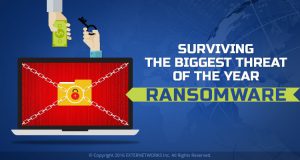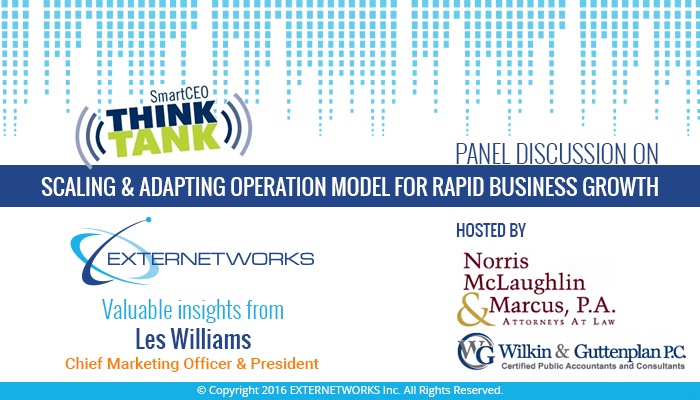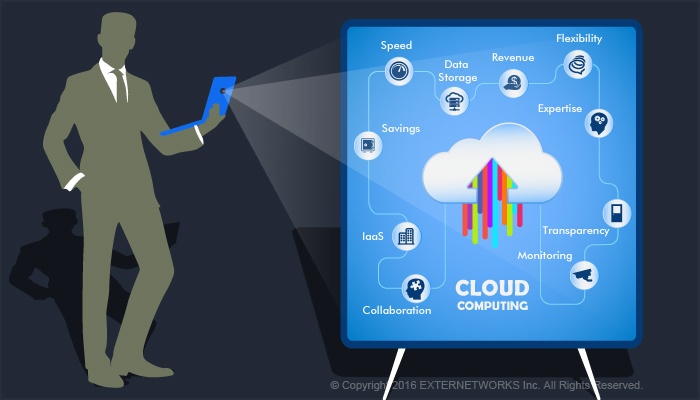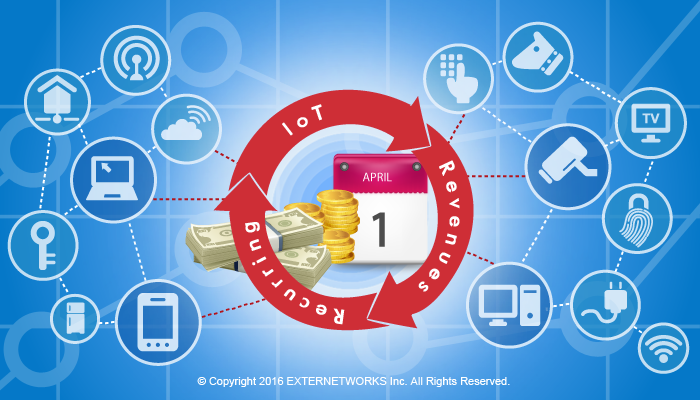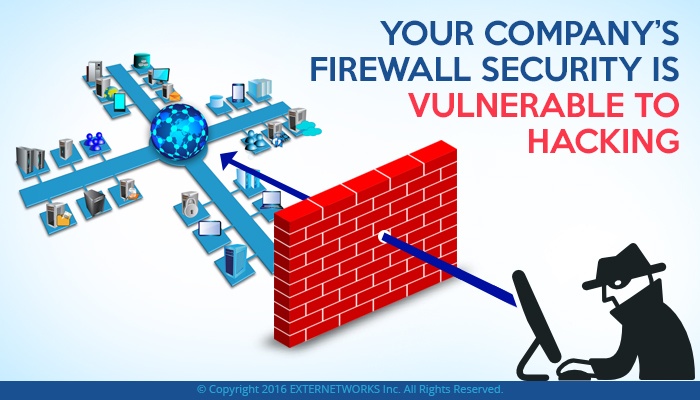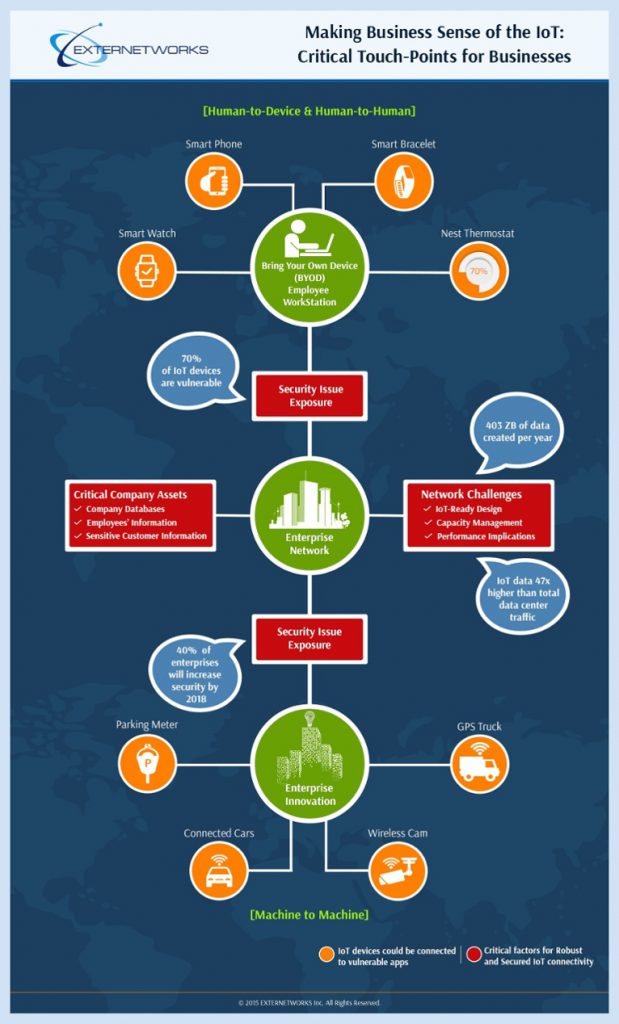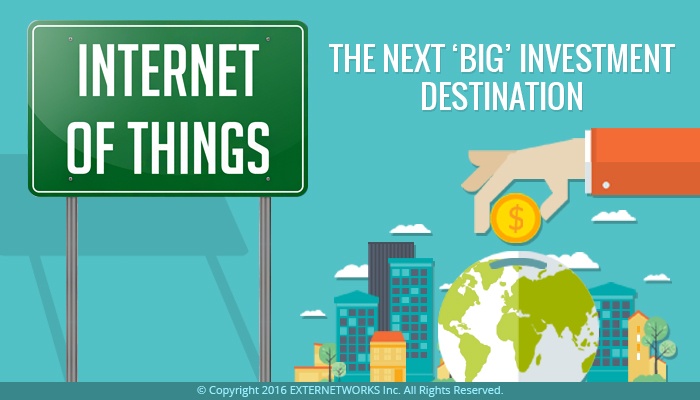Internet of Things (IoT) – The Next ‘BIG’ Investment Destination
With the IoT emerging as the next big destination for investment, many industry giants are scrambling and fiercely competing to grab their share of the revenues in the IoT market. While the IoT offers great opportunities to businesses for making money, it also poses bigger security challenges, than ever before, to your enterprise infrastructure. As an organization, how will you make the best of the IoT and deal with the impending challenges? Read on……
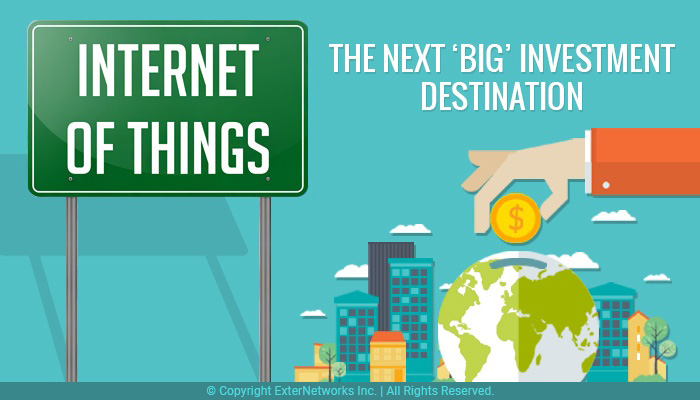
Investing In the Internet of Things
The next big investment destination is right here. It’s called the ‘Internet of Things’ (IoT), and big Blue Chip companies, such as IBM, Intel, and Cisco, are quickly ramping up their IT infrastructure and are investing in the IoT technologies to take a lead in this next era of technology. IBM’s announcement of $3 billion for a business unit that will focus on the development of solutions for the IoT is a key validation of the business potential of this market; also, a key beacon of the fierce competition shaping up amongst these giants to gain a lion’s share of the coveted IoT revenues. Amazon is still outpacing its cloud competitors; might IoT be its blind spot that allows IBM to take the lead? Does Amazon Web Services (AWS) have something in the works for IoT to close this opening? Who is going to be the AWS of IoT?”
IoT – A ‘MULTI-TRILLION DOLLAR’ OPPORTUNITY CHASE
While IBM’s latest IoT investment comes with some fanfare, it is not the first. We have seen many companies invest in the IoT in more subtle ways; so if you were not paying close attention, you could have missed them because most of these investments did not have a direct terminology association to the IoT. For example, Apple’s big Apple Watch launch does not tout the investment dollars designated by Apple, but anyone could assess that investments in billions of dollars went into building this new line of wearable product; in other words, this was Apple’s IoT investment.
Looking back, significant IoT investment got a kick-start in 2012, when $752 million was invested globally on IoT across 112 deals. Most IoT deals were an extension of these investing companies’ Cloud and Big Data strategy, which has evolved over time with the increasing number of internet-aware sensors across all industry verticals. As we can see with IBM, this new investment is a natural outgrowth of its acquisition of SoftLayer in 2013 – IBM forayed into the cloud by investing $1 billion, which enabled IBM SoftLayer to open up new data centers worldwide. With the new IoT initiative, IBM has now positioned itself for a leadership position in the IoT. Maybe it may just give the juice to their cloud initiatives and allow them to surpass Amazon, Microsoft and Google, who have kept them in check in the ramp of their cloud market share. Regardless, IBM is up for a serious challenge from other giants, some of who have closed subtle deals and are in “stealth” operation mode. One in particular is Google, which spent more in a day ($3.2 billion) to buy Nest (maker of internet-connected thermostats) than IBM spent in four years on its new unit. Google spent $555 million to buy Dropcam – a maker of internet-connected video cameras – to integrate connected cameras to Nest’s array of connected thermostats and smoke detectors.
Two companies that stand to benefit a great deal from all of this and are feverishly innovating are Intel and Qualcomm. For the chip-maker Intel, IoT is an opportunity to sell a lot more chips that could be integrated into all these devices and also power the servers. Qualcomm, the largest chipmaker in the world, acquired Cambridge Silicon Radio (CSR), a UK-based semiconductor company (which sells chips for printers, cars, and wireless audio) and a pioneer in Bluetooth technology for machine-to-machine communication, in 2014, for $2.5 billion. This acquisition is expected to drive the company’s growth by 8% to 10% in the coming years by fortifying its position in providing critical solutions for the IoT market.
Other industrial giants such as General Electric (GE), Siemens, and Hitachi, all see a great opportunity in IoT, with all of them striving to make their industrial equipment smarter, and their business processes better to be able to internalize, analyze, and act upon the real-time data produced by the machines, production lines, supply chains, etc. More than $1 billion of GE’s revenues came from some 43 ‘industrial internet’ offerings, with the biggest buyers being aviation and locomotive customers.
Overall, the IoT offers a compelling reason for all the investments in cloud, data centers, global networks, big data analytics, and power-sipping chips. Cisco’s 10,000 connected-equipment customers make up $2.4 billion in revenues out of the company’s total of $49 billion. According to the estimates of Cisco Consulting Services, IoT has the potential to unleash $19 trillion of global economic value, by 2024, through new innovations, revenues streams, better customer experiences, enhanced asset utilization, improved employee productivity, and efficient supply chain and logistics operations. So what is your company doing about it?
A ‘HEAD START’ FOR START-UPS
Pixabay

Start up businesses can leverage productivity and profit through IoT
As the IoT shapes up with large revenue potentials, investment by these blue chips acts as a validation and catalyst for start-up entries. Start-ups look to compete and build the next overtaking empires on the premise of focused IoT offers, while some look to innovate quickly and position themselves for acquisition, e.g. Nest. This, in turn, is driving what we are beginning to see with the increased venture capital (VC) financing into the IoT industry. This financing is heavily concentrated at seed stages, with more than 56% of the total VC funding on start-ups. Table-1 shows a list of the top-funded IoT start-ups by venture capitalists.
Table-1: IoT Startups Funding
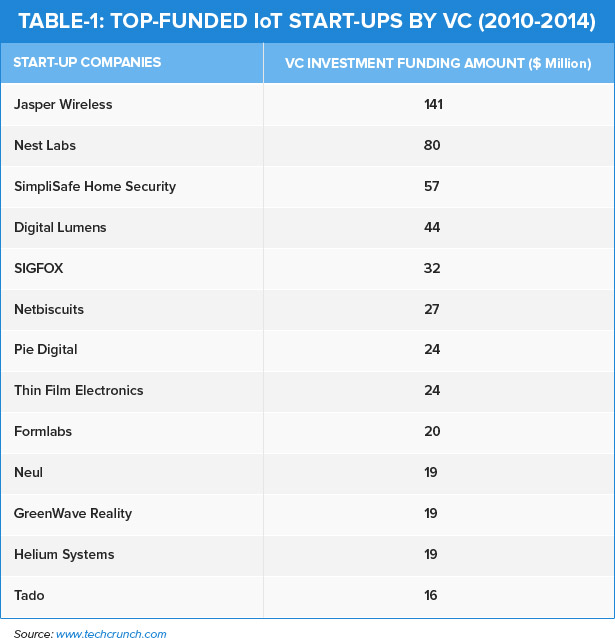
The number of start-ups in the IoT rose rapidly from just 13 in 2013 to 189 in 2014. As on October 2014, more than 300,000 people have jobs related to the IoT.
Moonscape Ventures, a $120 million VC firm, based in Tel-Aviv, was launched in August 2014 and focuses on start-ups in the IoT related technologies. The firm makes seed investments ranging from $500,000 to $5 million in new and innovative technologies in a wide array of sectors related to the IoT, including big data, smart cities, and news and media technologies.
Salesforce Ventures, launched in September 2014, with $100 million fund, invested in 2lemetry Inc., a Denver-based start-up, which provides a platform for business enterprises to connect wearables, sensors, or devices in larger systems and transform their IoT data into application and actionable insights. Through its Strategy and Innovation Center, launched in 2013, Samsung invests in the IoT start-ups via Samsung Ventures. Samsung backed Ineda Systems, which develops low-power SOC chips applicable to wearable devices such as smartwatches, health and fitness trackers, as well as the IoT. In August 2014, Samsung acquired SmartThings, a provider of open hub platform that connects internet to everyday items, for $200 million.
Related Post: Leverage IoT Technologies to Sustain Competitive Business Advantage
THE FUTURE OF THE IoT FOR BUSINESSES & CONSUMERS
The IoT is transforming the everyday physical objects surrounding our informational ecosystem that will enrich our lives. From houses and parking lots to refrigerators and coffee-makers, the IoT is adding more and more things into the digital fold every day, which is likely to make the IoT a multi-trillion dollar industry in the near future.
Although businesses can benefit more from the IoT, consumers are not to be discounted. The IoT can help consumers achieve goals by vastly improving their decision-making abilities via the augmented intelligence of the IoT. Through the IoT, businesses can achieve superior process optimization and efficiencies by gathering and reporting on data extracted from the business environment. Several businesses are adding sensors to people, places, products, and processes to collect and analyze information for better decision-making and increased transparency.
While the IoT represents the convergence of advances in miniaturization, wireless connectivity, increased data storage capacity and batteries, the IoT would be impossible without sensors, which are also an inseparable part of the IoT. Sensors identify and measure changes in light, temperature, position, etc., and are essential to turn billions of objects into data-generating ‘things’ that can report on their status and also interact with their environment. As sensor endpoints primarily enable the IoT, sensor investments are an indicator of the IoT’s progress. Below is an excerpt summary of PwC’s 6th Annual Digital IQ, 2014, survey results that gives an indication of company’s plans to invest in sensors; listed in order of importance to the IoT through investment in sensors.
- 20% of companies invested in sensors in 2014, compared with 17% in 2013.
- 25% of top performers (survey respondents whose companies are in the top quartile for revenue growth, profitability, and innovation) invested in sensors in 2014, compared with 18% in 2013
- 54% of top performers said they would invest more on sensors in 2014.
- 14% of respondents said sensors would be given the utmost strategic importance to their companies in the next 3-5 years, compared with other emerging technologies.
Table-2 Shows a Geographical Picture of Investment in Sensors:
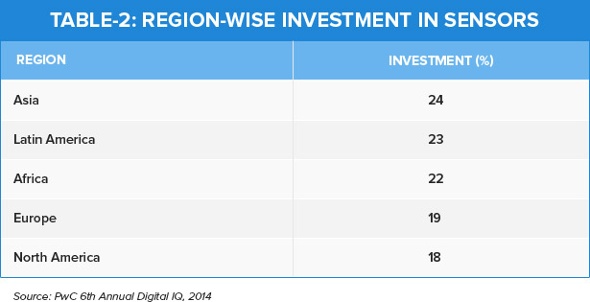
Table-3 Shows the Top-10 Investments in Sensors by Industry:
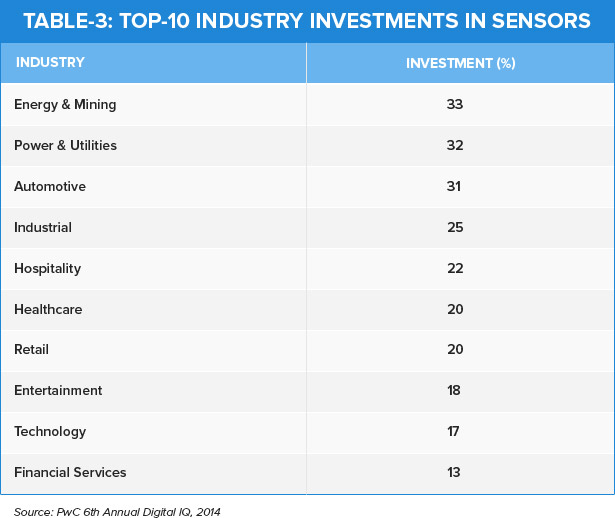
THE BIGGEST CHALLENGE: SECURITY OF THE IoT
While IoT offers a world of opportunities for making tons of revenues, there is no doubt that the emergence of the IoT also creates significant and complex challenges for those responsible for protecting information networks and physical environments. According to Cisco, while 10.69 billion things were connected until October 2013, the figure rapidly rose to 13.69 billion in October 2014. While only 37% are industrial consumers of the IoT at present, the figure is expected to surpass 50% by 2017. The data generated by machines today is only 11% of the total data, but it is estimated to rise to 40% by 2020, according to IDC, with 20-50 billion devices fueling the growth. All these are expected to pose problems with securing the data.
According to Federal Trade Commission (FTC) panelists, the IoT devices may present several potential security hazards that could be exploited to harm consumers by (1) enabling unauthorized access and misuse of personal information; (2) facilitating attacks on other systems; and (3) creating safety risks.
Although each of these risks exists with traditional computers and computer networks, they are intensified in the IoT ecosystem. Although the present risks may be small, they could be amplified with the increase in the number of fully-automated cars and other automated physical objects.
Moreover, unauthorized access to internet-connected cameras or baby monitors also poses potential physical safety concerns. Similarly, unauthorized access to data collected by fitness and other devices that track consumers’ location over time could jeopardize consumers’ physical safety. Another possibility is that a thief could remotely access data about energy usage from smart meters to determine whether a person is at home or away. These potential risks are magnified by the fact that securing connected IoT devices is more challenging than securing a home computer for two reasons. Firstly, companies entering the IoT market may lack the expertise in dealing with security issues. Secondly, although some IoT devices are highly sophisticated, many others may be economical and, importantly, dispensable. In such cases, if a vulnerability were discovered after manufacture, it may be difficult or impossible to update the software or apply a patch. So when you think about investing in the IoT; security measures must be a critical component of the design.
HOW EXTERNETWORKS CAN HELP YOU
As the IoT embraces the mainstream of business with the proliferation of wearable technologies and smart devices, you will have to successfully overcome the challenges related to managing humongous amounts of data generated by your organization, while simultaneously securing its organizational infrastructure and network. Managed Services Providers (MSPs), such as ExterNetworks, can help businesses exploit the IoT technologies optimally by creating new business models. We are the innovative arm for organizations that don’t have the resources to constantly upgrade or maintain high-speed IT networks that are IoT-compatible.
Business transformation is at the core of our services strategy, with a goal to help you innovate to generate revenue or gain productivity and cost efficiencies. We do this by delivering customized solutions and quality services that enable our clients to maximize performance, save resources, and stay secure. You can leverage one of the following solutions to quickly get going with your IoT initiatives:
- Consulting and Professional Services: We have a strategic, tailored approach when it comes to consulting customers so they can leverage their IT infrastructure to achieve process improvement, which leads to an effective service management environment. E.g. Network Design and Optimization to deliver the best high-performing infrastructure that meets the business objectives and improve its competitive advantage.
- Managed Security Services (MSS) : We employ a systematic approach to managing our customers’ security needs for a reliable, secure and optimal performing environment. Our MSS includes 24/7 monitoring and management, overseeing upgrades, performing security assessments and security audits, and responding to emergencies.
- Integrated Network Solutions: We offer best-in-class Network Integration services that ensure every component is fully integrated with any pre-existing hardware and software and that all system elements function flawlessly as a whole. Our services provide strategy, architecture, design and deployment to build rigorous security solutions into our customers’ infrastructure.


